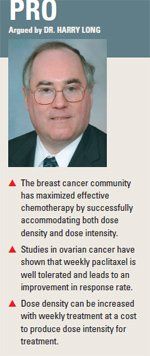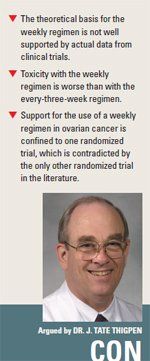Advanced ovarian carcinoma: Does a high-dose short-duration schedule of paclitaxel trump prolonged low-dose therapy?
A weekly course of paclitaxel has proved itself effective in breast cancer and is feasible in ovarian cancer as well. But questions remain as to the actual benefits of a shorter treatment course.
ABSTRACT: A weekly course of paclitaxel has proved itself effective in breast cancer and is feasible in ovarian cancer as well. But questions remain as to the actual benefits of a shorter treatment course.
According to the Norton-Simon hypothesis, chemotherapy results in a rate of regression in tumor volume that is proportional to the rate of growth for an untreated tumor of the same size. The hypothesis suggests that when treating micrometastases, high-dose short-duration treatment, either with a single drug or a drug combination, that is followed sequentially by a non-cross-resistant treatment may be preferable to prolonged-duration low-dose therapy.
This treatment model has proved effective in breast cancer, pointed out Harry Long, MD, professor of oncology at the Mayo Clinic College of Medicine in Rochester, Minn. "We were able to take doxorubicin and cyclophosphamide in a regimen that was well tolerated on a three-week schedule, move it up to a two-week schedule with bone marrow growth factor support, and achieve a higher time to progression and survival. Can we do the same with ovarian cancer?" Yes, according to Dr. Long, who spoke in favor of a dose-dense paclitaxel (Taxol) schedule at the 2009 Oncology Congress in San Francisco.
But taking up the argument for caution in interpreting data on a shorter, more intense therapeutic course was J. Tate Thigpen, MD, professor of medicine and director of the division of medical oncology at the University of Mississippi Medical Center in Jackson. "Only one trial to date suggests that weekly dose- dense paclitaxel is superior to every-three-week paclitaxel; whereas earlier studies of single agent weekly paclitaxel vs every three week paclitaxel in the recurrent disease setting suggested no significant difference between the two schedules. In addition, the population in the Japanese study was considerably less diverse than the typical U.S. or European study. Final conclusions must await a confirmatory U.S. trial that has been awaiting NCI clearance for activation for almost one year, GOG 262."
A shorter course: Reasonable but feasible?
"If you have a lower-dose therapy, given at certain intervals, you get so many log cells killed and tumor recovery between treatments," Dr. Long said. "If you give a higher dose of a drug, or a regimen that kills more cancer, you can accomplish more cell kill in a given period of time. And if you can move up the therapy so that you reduce the recovery, you can accomplish more total cell kill. So dose density certainly seems reasonable. The question is: Is it feasible?"


To answer that question, Dr. Long cited the results from several clinical trials, such as the Gynecologic Oncology Group (GOG) trial 097. In this study, ovarian cancer patients received the same total dose of cyclophosphamide and cisplatin that was delivered over four three-week cycles or eight three-week cycles. The trial leaders found no difference in overall survival (OS), progression-free survival (PFS), or response rate (Semin Oncol 24:S213-S216, supplement 2, 1997; Semin Oncol 23:40-47, supplement 12, 1996).
More recent studies out of M.D. Anderson Cancer Center and the Royal Marsden Hospital in London noted that weekly paclitaxel was well tolerated. The Houston-based researchers found that weekly paclitaxel at a dose of 80 mg/m2 turned in a 21% response rate in previously treated patients. In the UK study, the dose was between 80 mg/m2 and 100 mg/m2 per week in previously treated and untreated patients, and the overall response rate was 48%. The median PFS was 4.8 months and OS was 13.5 months (Gynecol Oncol 101:436-440, 2006; Gynecol Oncol 109:27-32, 2008).
"Weekly paclitaxel is certainly feasible," Dr. Long said, although he pointed out that "if you look at the per mg/m2 per week schedule, this isn't too far off from the 175 mg/m2 every three weeks that has been the standard of therapy."
However, in other trials, when paclitaxel was combined with carboplatin, toxicity was a major problem. Weekly paclitaxel doses included 90 mg/m2 and carboplatin with an AUC of 4, and paclitaxel at 100 mg/m2 per week with carboplatin with an AUC of 2. "The higher the dose of chemotherapy, the greater the toxicity," he said. "If you want to give carboplatin in probably the worst possible way, you can give it weekly. It has cumulative myelosuppression, and after one or two cycles you won't be able to give any more. And that was found in the weekly schedules."
The Japanese Gynecologic Oncology Group conducted a study that upped the paclitaxel dose to 180 mg/m2 and also gave carboplatin once every three weeks at an AUC of 6. "They got an overall response rate of 53%, a median PFS of 17 months, and a two-year OS of 77.7%," Dr. Long explained. "They used dose stacks,
paclitaxel-carboplatin with paclitaxel of 80 mg/m2 weekly and carboplatin every three weeks, so there was no attempt at a dose-dense increase in carboplatin. And they got an overall response rate roughly the same as the standard regimen, but they increased median PFS to 27.9 months, and two-year OS to 83.6%. Both were statistically significant" (Lancet 374:1331-1338, 2009; ASCO 2008 abstract 5506).
On the basis of these results, Dr. Long answered yes to the feasibility question. On a weekly schedule, the dose density of paclitaxel was increased by about 30%, although it came at the cost of a reduction in dose intensity per treatment. "The [Japanese] randomized clinical trial does convincingly show that dose-dense, dose-intense chemotherapy with paclitaxel and standard carboplatin is superior to standard once-every-three-week paclitaxel and carboplatin," he said.
Weekly paclitaxel offers limited benefit
In theory, weekly paclitaxel has many pluses, according to Dr. Thigpen. It is a cycle phase-specific agent, active in the late G2/M interface, so the longer the duration that the drug is given, the better the efficacy. Also, paclitaxel has antiangiogenic properties that are boosted by prolonged administration.
But do these benefits always manifest in a real-world setting? Not necessarily. Dr. Thigpen pointed to several trials that were not able to show the superiority of weekly paclitaxel as well as other alternative schedules (96-hour infusion vs 24-hour infusion in newly diagnosed patients, 24-hour infusion vs 3-hour infusion in recurrent disease, weekly paclitaxel vs every-three-week paclitaxel in recurrent disease).
As for antiangiogenic properties, the GOG 178 trial demonstrated a median PFS advantage of seven months in favor of the 12-month paclitaxel arm. At the time of study closure, there was no evidence of an OS benefit for the 12-month paclitaxel arm (J Clin Oncol 21:2460-2465, 2003).
"So I don't think at the present time we could say that there's clear evidence that the antiangiogenic properties of paclitaxel demand that it be given in a schedule more frequently than every three weeks," Dr. Thigpen stated (see Vantage Point).
Finally, proponents of weekly paclitaxel claim less neurotoxicity and less myelosuppression than with a longer regimen, he said, but results from the previously mentioned Japanese trial don't support that claim. In that study, 113 of 312 patients in the dose-dense regimen were taken off-study because of toxicity vs 69 of 319 in the standard-treatment arm (Lancet 374:1331-1338, 2009).
"The original goal of this study was to include 380 patients," Dr. Thigpen said. "But that goal was changed in mid-spring, based on one analysis, to include a total of 600 patients. When you do that in a study, you automatically introduce statistical bias based on what you've seen so far in the study. So that introduces a major statistical problem in this trial."
Finally, even research that doesn't necessarily suffer from design flaws doesn't show a benefit to weekly paclitaxel, Dr. Thigpen said, pointing to a study out of M.D. Anderson that assigned 258 patients to either 12 cycles of weekly paclitaxel or four cycles of every-three-week paclitaxel plus four cycles of standard therapy. While the response rate was better in the weekly treatment arm, PFS and OS were not increased, he said (J Clin Oncol 23:5983-5992, 2005).
VANTAGE POINT'High time' for a phase III dosing schedule trial in U.S. women

Oncology has a great tradition of performing phase II, randomized trials, said Dr. Alberts, director of the Arizona Cancer Center at the University of Arizona in Tucson, but the results don't always provide definitive answers. Instead, they often highlight the questions that need to be asked more than once.
In the case of the Japanese Gynecologic Oncology Group research, the trial "suggested that it was high time that we had a similar phase III trial in the U.S.," Dr. Alberts said. "What it did was to ask 'Can we use this drug in a more effective way?' It was a well-performed, phase III clinical trial, and they answered the question-for a Japanese population."
But Japanese women metabolize drugs differently than U.S. women and they have a different tolerance level, Dr. Alberts pointed out. While treatment options are certainly influenced by phase III clinical trial results, the experiment "must be recapitulated in the population that you are dealing with. We shouldn't be dependent on the Japanese to answer the question for us. They answered the question for their own population, not ours," he said.
Still, the take-home message from the Japanese trial is a promising one: OS at three years was higher in the dose-dense regimen group than in the conventional-treatment group (P = .03). While there was more participant dropout in the dose-dense group because of toxicity, the devil may be in the details.

"I think Dr. Thigpen is appropriately concerned about looking at the patients who went off-study because of toxicity," Dr. Alberts said. "In general, there is more toxicity [with the dose-dense regimen], for example, with myelosuppression, 92% vs 88% for neutropenia, although that's not statistically significant. Anemia was more common, 69% vs 44%, but when you look at the really serious adverse events, such as febrile neutropenia, it was 9% vs 9%. So the dose-dense regimen was more toxic in terms of anemia, but we certainly know how to deal with anemia."
Dr. Alberts also suggested that the key figures to look at in the Japanese study were the number of cycles given: 140 patients in the dose-dense group received six cycles vs 174 patients in the extended-therapy group. Similarly, 38 patients in the dose-dense arm received nine cycles, while 51 patients in the comparative arm received nine cycles.
"If you look at the number that received greater than or equal to six cycles in both arms, it's 192 patients vs 232 patients. You can almost say, 'Look how much better the results were for the dose-dense schedule despite the fact that fewer cycles were received.' It's not necessarily bad to have fewer cycles if the results were improved PFS and overall survival," he said, adding that the hazard ratio of 0.75 indicated a 25% reduction in risk of mortality.
"You can't base all of your decisions on one study," Dr. Alberts cautioned. "But when you get a lead like this, you have to follow it. When you see a survival advantage on a different schedule, you have to take note of that."
Upcoming trials will certainly offer more ammunition for this ongoing discussion. GOG 252 is a phase III clinical trial of bevacizumab (Avastin) with intravenous vs intraperitoneal chemotherapy in ovarian, fallopian tube, and primary preitoneal carcinoma. GOG 252 also will examine a weekly schedule vs a once-every-three-week schedule for paclitaxel, Dr. Alberts said.